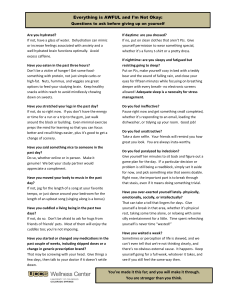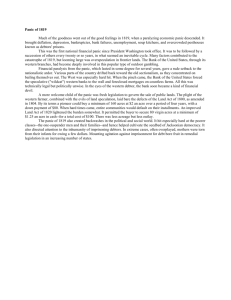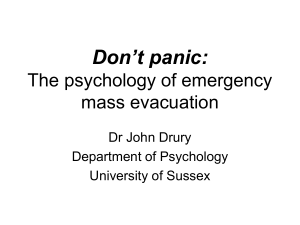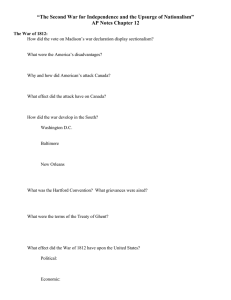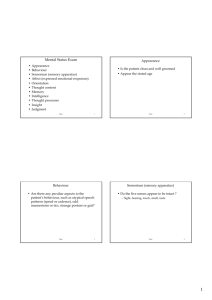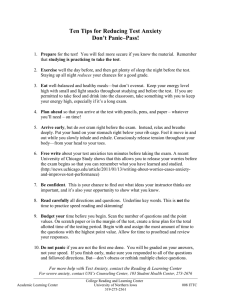A Study of Coping Strategies in Emergencies with Group Panic... Places Han Wang
advertisement
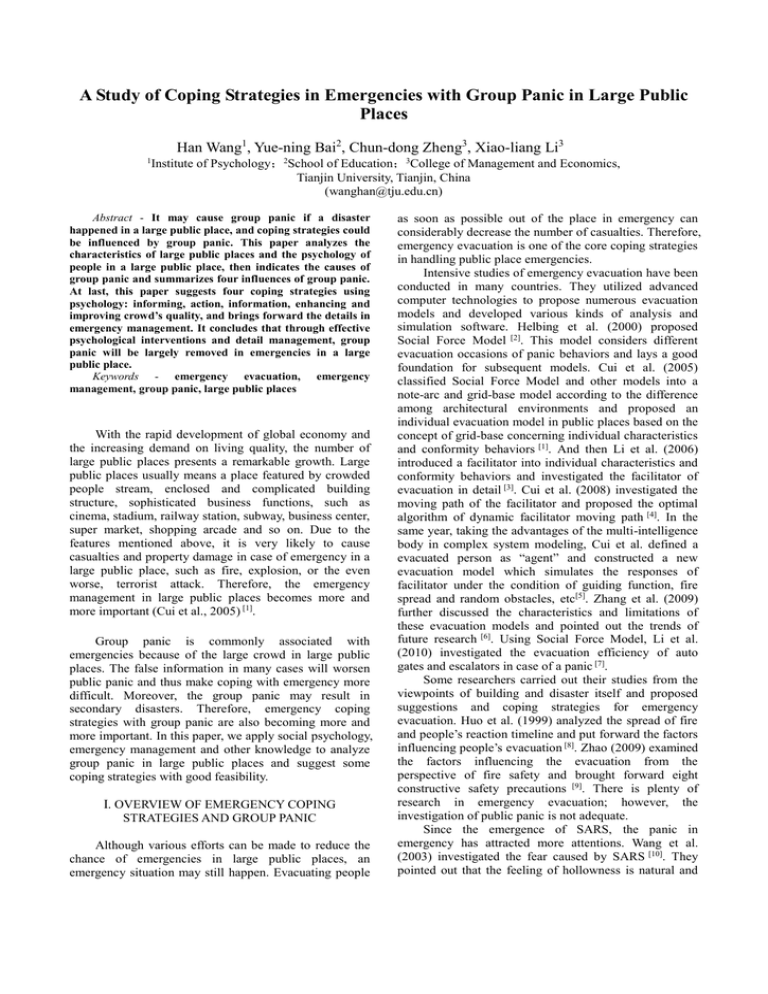
A Study of Coping Strategies in Emergencies with Group Panic in Large Public Places Han Wang1, Yue-ning Bai2, Chun-dong Zheng3, Xiao-liang Li3 1 Institute of Psychology;2School of Education;3College of Management and Economics, Tianjin University, Tianjin, China (wanghan@tju.edu.cn) Abstract - It may cause group panic if a disaster happened in a large public place, and coping strategies could be influenced by group panic. This paper analyzes the characteristics of large public places and the psychology of people in a large public place, then indicates the causes of group panic and summarizes four influences of group panic. At last, this paper suggests four coping strategies using psychology: informing, action, information, enhancing and improving crowd’s quality, and brings forward the details in emergency management. It concludes that through effective psychological interventions and detail management, group panic will be largely removed in emergencies in a large public place. Keywords - emergency evacuation, emergency management, group panic, large public places With the rapid development of global economy and the increasing demand on living quality, the number of large public places presents a remarkable growth. Large public places usually means a place featured by crowded people stream, enclosed and complicated building structure, sophisticated business functions, such as cinema, stadium, railway station, subway, business center, super market, shopping arcade and so on. Due to the features mentioned above, it is very likely to cause casualties and property damage in case of emergency in a large public place, such as fire, explosion, or the even worse, terrorist attack. Therefore, the emergency management in large public places becomes more and more important (Cui et al., 2005) [1]. Group panic is commonly associated with emergencies because of the large crowd in large public places. The false information in many cases will worsen public panic and thus make coping with emergency more difficult. Moreover, the group panic may result in secondary disasters. Therefore, emergency coping strategies with group panic are also becoming more and more important. In this paper, we apply social psychology, emergency management and other knowledge to analyze group panic in large public places and suggest some coping strategies with good feasibility. I. OVERVIEW OF EMERGENCY COPING STRATEGIES AND GROUP PANIC Although various efforts can be made to reduce the chance of emergencies in large public places, an emergency situation may still happen. Evacuating people as soon as possible out of the place in emergency can considerably decrease the number of casualties. Therefore, emergency evacuation is one of the core coping strategies in handling public place emergencies. Intensive studies of emergency evacuation have been conducted in many countries. They utilized advanced computer technologies to propose numerous evacuation models and developed various kinds of analysis and simulation software. Helbing et al. (2000) proposed Social Force Model [2]. This model considers different evacuation occasions of panic behaviors and lays a good foundation for subsequent models. Cui et al. (2005) classified Social Force Model and other models into a note-arc and grid-base model according to the difference among architectural environments and proposed an individual evacuation model in public places based on the concept of grid-base concerning individual characteristics and conformity behaviors [1]. And then Li et al. (2006) introduced a facilitator into individual characteristics and conformity behaviors and investigated the facilitator of evacuation in detail [3]. Cui et al. (2008) investigated the moving path of the facilitator and proposed the optimal algorithm of dynamic facilitator moving path [4]. In the same year, taking the advantages of the multi-intelligence body in complex system modeling, Cui et al. defined a evacuated person as “agent” and constructed a new evacuation model which simulates the responses of facilitator under the condition of guiding function, fire spread and random obstacles, etc[5]. Zhang et al. (2009) further discussed the characteristics and limitations of these evacuation models and pointed out the trends of future research [6]. Using Social Force Model, Li et al. (2010) investigated the evacuation efficiency of auto gates and escalators in case of a panic [7]. Some researchers carried out their studies from the viewpoints of building and disaster itself and proposed suggestions and coping strategies for emergency evacuation. Huo et al. (1999) analyzed the spread of fire and people’s reaction timeline and put forward the factors influencing people’s evacuation [8]. Zhao (2009) examined the factors influencing the evacuation from the perspective of fire safety and brought forward eight constructive safety precautions [9]. There is plenty of research in emergency evacuation; however, the investigation of public panic is not adequate. Since the emergence of SARS, the panic in emergency has attracted more attentions. Wang et al. (2003) investigated the fear caused by SARS [10]. They pointed out that the feeling of hollowness is natural and has practical meanings. They also came up with detailed psychological mechanisms and methods to control excessive panic. Chen (2003) pointed out that timely and proper disclosure of information will effectively decrease the level of panic [11]. Wang (2003) analyzed the cause of formation and eliminating methods of public panic in a systemic approach [12]. From the viewpoint of sociology, Qin et al. (2006) studied the adverse psychological response of people in emergency with respect to the dimensionalities of public right to know, social trust, and public management [13]. Chen et al. (2009) constructed the spreading model of panic through information computation [14]. This laid a good foundation of studying panic spreading for more scientific research works. As summarized above, the coping strategies in emergencies in public places are mainly from the perspective of emergency evacuation. These research works are very intensive and individual panic and group conformity behaviors have already been taken into consideration. However, there is no further study about group panic, the consequence of which is much more serious than that of group conformity behavior. Therefore, this paper thoroughly extends the study of coping strategies in emergency with group panic occurring in large public places. II. REASONS CAUSING GROUP PANIC IN LARGE PUBLIC PLACES Solomon (1998) pointed out that a serious emergency is a kind of situation in which individuals are not able to resist and lose control [15]. The individual in such a situation may be at a loss and disabled. When most individuals exhibit panic emotions, it can be confirmed that the group panic have happened in the group. Strictly speaking, group panic is the psychology of fear and nervous emotions in the whole group and causes irrational and non-cooperation behaviors dominated by this psychology state when a given group is facing a sudden or an unimaginable threat. Group panic is a kind of public panic. It specifically refers to the panic of a certain group. Public panic is mainly influenced by mass communication, rumor, pressure from the crowd and collective behavior [12]. Once group panic breaks out in a large public place, it has four characters which are also the causes for the formation and spread of panic. Firstly, the subject of the group panic is the group of people in public place instead of social public. The scope of the subject has a certain restriction and the panic spreads more rapidly. Secondly, the group panic being studied in this research is caused by emergency and actual event. However, we cannot assure the equal level of recognition to the event between the group and the administrator of the public place. That is to say, false information may be generated in the group by information asymmetry. Thirdly, people in group panic are personally experiencing the event instead of acquiring it from the mass media. Thus the panic is more likely to happen psychologically. Fourthly, the physical environment of a large public place is usually finite and even enclosed and the density is usually very high. The crowded group makes people worry about failing to escape and thus makes people panic. When an emergency happens, the public usually has adverse psychological changes, including fear, anxiety, pressure, frustration, attack, guilt, conformity and excessive prevention [13]. Although the emergency is real, people may spread some exaggerated or false information because of fear and anxiety and in turn increase the level of group panic. People will also have conformity psychology and behavior, leading to collective behavior. Collective behavior originates from three aspects: high degree of irritation and implication, emotional contagion and emotional arousal [12]. Under the pressure of the group, the individual will lose his discretion and is unable to think of the consequence of his behavior. The people in a high density will result in the most inclinable contagion of panic emotion and accelerate its spread. Therefore, once an emergency occurs, providing that the group panic is not dredged properly, the cyclical reaction of panic will be triggered and group panic will be worse. As can be seen from above, the group panic in large public places originates mainly from the influence of emergency to the group psychology, which has random, uncertain and incremental characters. Using the Sand Pile Model, Zhang et al. (2009) described the characteristics of panic spread [16]. Similarly, the model can also be used to describe group panic. Different psychological changes of each individual gradually impact the whole group’s psychology and behaviors. When the influence reaches a critical point, the whole group’s psychology and behaviors will become unstable. Just like the last sand which leads to the collapse of a sand pile, the last subtle change in psychology and behavior will trigger group panic. Moreover, the characteristics of large public places accelerate the falling speed of sands, which increases the probability of group panic. III. EFFECT OF GROUP PANIC ON EMERGENCY MANAGEMENT IN LARGE PUBLIC PLACES It can be concluded from the cause analysis of group panic that once group panic occurs, the group has the following characteristics: people lose their discretion and are all at sea. They are easy to be misled by false views and conform to the idea of the group. Some people will even have psychoreactions such as attack or excessive prevention and produce violent behaviors. However, such reactions are not common to group panic. It can be learned that different levels of group panic may have different influence on the choice of emergencies coping strategies in large public places, especially on emergency evacuation. The authors illustrate the simple grading of group panic levels here. It is the lightest group panic if the group produces certain psychological panic but they can still clearly recognize the location of and direction to emergency exits. However, sometimes they may neglect the instructions of the guide. The second level of group panic is that some people are at a loss and cannot recognize emergency exits. Therefore the group will rush in every direction randomly and have some uncontrolled or aggressive movements. Some people may jump out from windows immediately and then many other people will follow and jump because of group conformity such as what happened in the event of September 11. The third level of group panic only happens in large-scale disasters such as various kinds of violence crimes after Haiti earthquake. Generally the group panic on such level will not occur in large public places and are out of the scope of this paper. First of all, group panic impacts the efficiency of emergency evacuation. The purpose of emergency evacuation is to make the group leave the scene as quickly as possible while the group panic will have the most direct influence on this purpose. When the group panic is on the first level, everyone wants to be the first one who runs away from that large public place. And this is the topic that the majority of emergency evacuation models have studied, namely group conformity seriously affecting the evacuation efficiency. There are many corresponding computational methods to study this issue. However, when the level has increased to the second or the third level, people begin to lose their way and cannot recognize emergency exits, which will make the emergency evacuation more complicated. And such evacuation problems cannot be solved by a fixed model. Secondly, group panic increases the uncertainty of emergency handling. Once group panic occurs, different people have different psychological endurance and will carry out different behaviors. The uncertainty caused by group panic of the first level is limited and it can only impact the evacuation efficiency. As the level of group panic increases, human evacuation behaviors will be different and evacuation efficiency will be under some uncertainty, which have impact on emergency evacuation for the most part and go against the method making and evacuation implementation. As the level of group panic increases, the uncertainty of emergency evacuation enhances, which further restricts the specific applications of various emergency evacuation models. Thirdly, group panic may trigger secondary disasters. It will trigger serious stampede once there is a phenomenon such as tumble when the group lose their head. The increase of the uncertainty in group panic will trigger other more serious secondary disasters. Lastly, group panic seriously impacts the implementation of emergency response plan. It can be known from the analysis above, group panic increases the uncertainty of emergency evacuation handling and emergency response plan itself may be unable to be adapted in an emergency occurring in reality. During the plan revision and exercises, there is no way to enumerate all issues triggered by group panic through eigenmode. Therefore, there are many difficulties in the implementation of emergency response plan. The failure to reach related workers in a timely manner may make mistakes in emergency evacuation because of the group panic in concrete procedures. IV. THE COPING STRATEGIES AND METHODS OF GROUP PANIC IN LARGE PUBLIC PLACES Through a study of domestic and oversea literature we found that emergency coping strategies mainly focus on the efficiency increases of emergency evacuation. It largely guides the design of public buildings and other infrastructure facilities and simulates different forms of built environments and disasters by computing emergency evacuation models. But this is only the precaution or proactive preparation. Emergencies themselves are various and it is impossible to cope with an emergency just relying on architectural design. What is also needed is the system and mechanism of emergency management. The development of emergency managing systems and flexible programs is a major approach to solve the problem. In this paper, the authors provide some solutions from the perspective of emergency management. Once an emergency happens, it is the first place to eliminate group panic. The authors consider that we can eliminate group panic from the following four aspects: informing, action, information encouragement and the enhancement of masses' quality. To begin with, informing refers to minimizing the degree of group panic through voice guidance when it occurs. Once an emergency occurs, the broadcasting system must start immediately and provide the group with latest information. The onsite guidance and useful evacuation directions should be provided and to increase people’s confidence. Secondly, action refers to immediately mobilizing people and facilities of departments concerned to be involved in handling the emergency and give people confidence after an emergency occurs. The emergency response system should be perfected from the perspective of emergency management. It mainly consists of three aspects: improving the emergency plan, strengthening the relevant emergency management and enhancing the personnel management. Thirdly, information encouragement refers to providing the group with sufficient emergency management information before the emergency happens and making the group confident enough in large public places. This includes two parts. The first is increasing the publicity of emergency management information so that the group can acquire related information. The second is perfecting the sign system in large public places. An excellent sign system can guide people to evacuate through right direction. Fourthly, increasing the quality of group refers to increasing the ability of group in coping with emergency as much as possible. Social psychology research shows that a good grasp of coping strategies to emergency is favorable in diminishing panic emotions. Through the daily popularized cognition of group to emergencies and increasing their self-help capabilities, the group becomes competent in coping with emergencies. V. CONCLUSIONS This research investigates the reasons and influence of group panic in large public places in detail and indicates that the emergency in large public places can easily cause group panic, which has complicated effects on emergency coping strategies. The group panic caused by an emergency in a large public place should firstly be prevented, decreased and diminished by psychological methods, followed by handling the event and people’s evacuation. This paper provides four suggestions and puts forward detailed measures from the perspective of emergency management. ACKNOWLEDGEMENT The research is supported by the Science and Technology Development Strategy Research Program of Tianjin (Grant No. 10ZLZLZF03500). REFERENCES [1] CUI Xihong, LI Qiang, CHEN Jin, CHEN Chunxiao, Study on occupant evacuation model in large public place: to consider individual character and following behavior(in Chinese), Journal of Natural Disasters, 2005,14(6):133-140. [2] Dirk Helbing, Llles Farkas, Tamas Vicsek. Simulating dynamical features of escape panic(in Chinese), Nature,2000,407:487- 490. [3] LI Qiang, CUI Xihong, CHEN Jin, Study on occupant evacuation process from large public facilities and effect of guidance (in Chinese), Journal of Natural Disasters, 2006,15(4):92-99. [4] CUI Xihong, LI Qiang, CHEN Jin, An algorithm for the moving route of evacuation leader in public facilities(in Chinese), China safety science journal, 2008,18(11):52-54. [5] CUI Xihong, LI Qiang, CHEN Jin, CHEN Chunxiao, Study on MA-based model of occupant evacuation in public facility(in Chinese), Journal of system simulation, 2008,20(4):1006-1023. [6] ZHANG Lu, TIAN Hong, Talking about the characteristics and development of evacuation model(in Chinese), Science & Technology information, 2009,(28):99-100. [7] LI Shengli, WEI Dong, LIANG Qiang, Study on evacuation efficiency of ticket gate and escalator under panic behavior (in Chinese), Fire science and technology, 2010,(2):103-105.) [8] HUO Ran, JIN Xuhui, LIANG Wen, Simulation analysis for people’s escape in large public building fire(in Chinese), Fire safety science, 1999,8(2):8-13. [9] ZHAO Zhizhong, Large supermarkets and stores’ fire safety evacuation research and countermeasures(in Chinese), Inner mongolia science technology & economy, 2009,(17):64-67. [10] WANG Xiaohong, LIN Chun, The psychological mechanism and self-adjust of SARS panic(in Chinese), Academic journal of pla postgraduate medical school, 2003,24(3):173-174. [11] CHEN Lidan, Fears of public opinion will stop in the information publicly(in Chinese), Practical journalism, 2003,(6):29-30. [12] WANG Huan, The cause of the group panic and its removal (in Chinese), Journal of Beijing university of posts telecommunications, 2003,5(3):1-4. [13] QIN Qiwen, ZHOU Yongkang, Deconstruction of the public’s negative reaction in the face of emergencies(in Chinese), Journal of southwest china normal universityHumanities and social sciences edition, 2006,32(1):86-91. [14] CHEN Xi, FEI Qi, LI Wei, A preliminary research on urban mass panic based on computational methods for experiment(in Chinese)Journal of huazhong university of science and technology- Social science edition, 2009,23(2):34-37. [15] Solomon. Utilization of EMDR in Crisis Intervention, Crisis Intervention and Time Limited Treatment,1998,239-246. [16] ZHANG Zhongquan, GAO Hongling, Research of panic spread self- organization critical model(in Chinese), Journal of university of international relations, 2009,(6):49-54.

